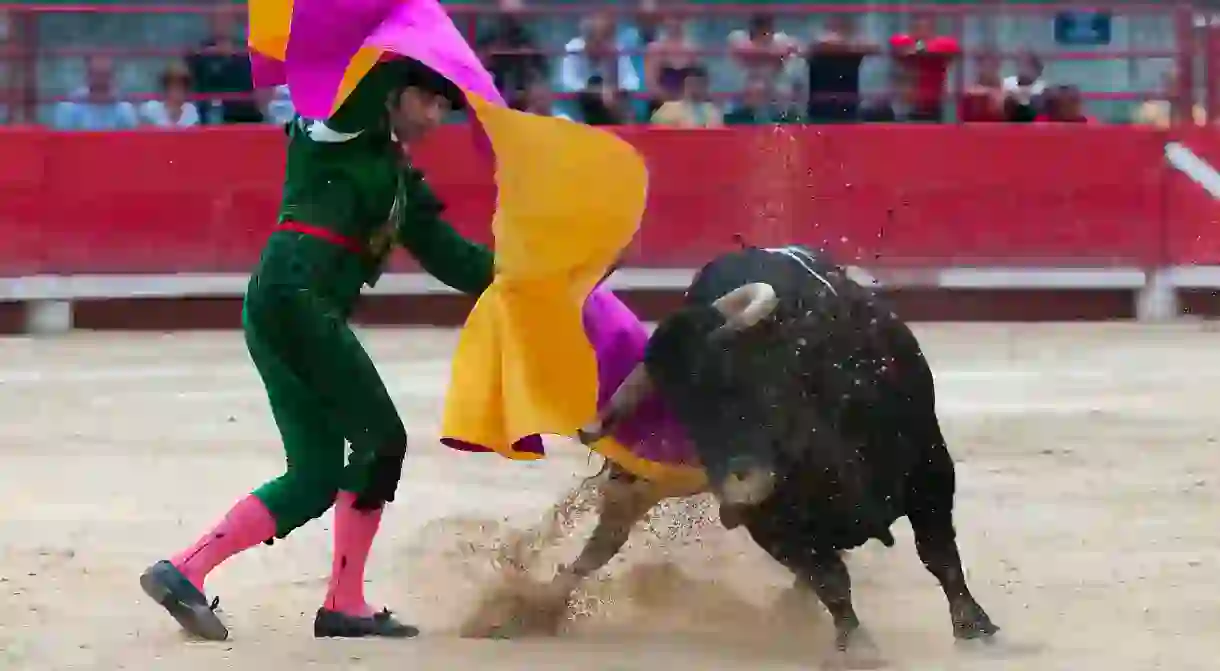10 Things You Didn’t Know About Spanish Bullfighting

Spain’s controversial cultural activity of bullfighting has plenty of detractors and plenty of supporters, with some believing it is a sport and a proud national symbol, and others believing it is just a barbaric form of animal cruelty that should be abolished once and for all. Here are 10 things you might not know about this controversial pursuit.
Bullfighting has an ancient history
Bullfighting has existed in some form for thousands of years. A depiction of male and female acrobats fighting a bull can be seen in wall paintings in Knossos, Crete, dating back to 2000BC. In Spain, the Moors refined the rough bullfighting of the conquered Visigoths into a spectacle performed on feast days, when Moors on horseback would kill the bulls. Modern-day bullfighting, in which matadors fight a bull on foot, was pioneered in 1726 by Francisco Romero.

The bulls are specifically bred for bullfighting
A particular breed of bull is used in bullfighting: the Spanish fighting bull, also known as the Toro Bravo. Some experts have traced the origins of the bull to the Iberian bulls used in Roman arena games. The bulls have been specially bred for their aggressiveness, and, unlike domestic bulls, will always charge at a target.
Not all bulls are killed in the ring
Some bulls, if they have displayed particularly brave and exemplary behavior in the ring, can be indultado, or pardoned. The crowd uses white handkerchiefs to persuade the president of the bullring to let the bull live, and in rare circumstances the bull is allowed to return to the ranch where it was raised and live out the rest of its natural days in peace.
http://instagram.com/p/BXvJ7-wHpNi/?taken-at=658931362
The biggest Spanish bullring is in Madrid
The Las Ventas bullring in Madrid is the biggest in Spain, but not the world; that accolade goes to the Plaza de Toros Mexico, in Mexico City. Las Ventas holds bullfights and is also home to a bullfighting museum, where you can trace the history of the tradition. If you’d like to visit but don’t think you would like to watch a bullfight, look out for the regular food markets and concerts held in the bullring.

Bullfighting is banned in some areas of Spain
Bullfighting is extremely controversial in Spain and is by no means loved by everyone. In 1991, the Canary Islands was the first Spanish region to ban bullfighting, followed by Catalonia in 2012. In 2016, the Spanish government overturned Catalonia’s ban, but several cities in the region, including Barcelona, have declared themselves “anti-bullfighting cities.”
Support for the tradition is at an all time low
A 2016 poll showed that the majority of Spaniards have no interest in bullfighting and that support is decreasing rapidly, especially among younger generations. The poll, conducted by IPSOS Mori, found that 93 percent of 16–24-year-olds do not support bullfighting, which begs the question: how much longer will the tradition survive as older generations who supported it pass on?

Spain has bullfighting schools for children
There are 15 bullfighting schools in Spain, which start teaching wannabe matadors at as young as 14 years old. The trainee bullfighters begin practicing on fake bulls, and then graduate to bull calves before they are allowed anywhere near the adult males. In 2015, the Spanish conservative government—which is a strong supporter of bullfighting—announced that it plans to make courses in bullfighting available as optional subjects for state school pupils.
http://instagram.com/p/BX7PkDBBLUj/?taken-at=658931362
There have been female bullfighters for over 100 years
While bullfighting is strongly associated with masculinity and machismo, there are actually some female bullfighters, and have been since the early 20th century. Chilean-born Conchita Cintrón is one of the most famous female bullfighters, and ignored bans on women fighting in the ring to kill over 750 bulls during her illustrious career that spanned the 1940s, ’50s and ’60s. One of the most famous modern-day female bullfighters is Cristina Sánchez, who took part in her first Madrid bullfight in 1993 and became a symbol of a new breed of female bullfighters during the 1990s. The female bullfighter was immortalized in Pedro Almodóvar’s Oscar-winning 2002 film, Talk to Her.

Bullfighting bars are a thing
Bullfighting fans congregate in bars dedicated to the practice to watch the latest bullfights, or even replays of old classics. The bars, such as La Torre del Oro on Madrid’s Plaza Mayor, are often decorated with bull heads, photos of famous bullfights and matador’s suits of lights. They are a good place to visit to get an insight into the practice and meet some true aficionados.
http://instagram.com/p/BUmGcOAjMhF/?taken-at=219179752
Bullfighter deaths are on the rise
Victor Barrio, aged 29, became the first matador to be killed in the bullring in Spain in over 30 years when he was gored to death in 2016. In June 2017, another Spanish bullfighter was killed in the ring after tripping on his cape. Iván Fandiño became the second bullfighter to die in less than 12 months during a bullfight in France. According to experts, over 500 bullfighters have been killed in the ring since 1700. But while in modern times bullfighter deaths have been relatively uncommon, injuries are not, with gorings a fairly regular occurrence.













